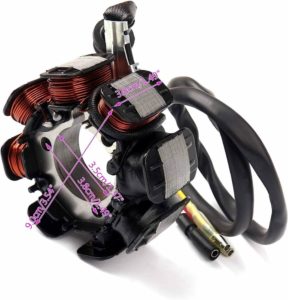Skid Plate: An Ultimate Guide to Protection and Performance

In the world of off-road adventures and rugged terrains, the term “skid plate” holds significant importance for vehicle owners and enthusiasts alike. A skid plate is a protective barrier designed to safeguard the undercarriage of a vehicle from potential damage caused by rocks, debris, and uneven surfaces. This seemingly simple accessory plays a crucial role in enhancing the durability and longevity of your vehicle, ensuring a smooth and worry-free ride, no matter the terrain.
Benefits of Using a Skid Plate
Enhanced Undercarriage Protection
The primary benefit of installing a skid plate is the added protection it provides to the vital components located underneath your vehicle. These components, such as the engine oil pan, transfer case, and fuel tank, are vulnerable to impacts and abrasions when traversing rough terrains. A skid plate acts as a shield, deflecting rocks, branches, and other obstacles, preventing costly repairs and minimizing the risk of breakdowns.
Improved Ground Clearance
Many skid plates are designed to be slightly elevated, which effectively increases the ground clearance of your vehicle. This added clearance allows for greater maneuverability and reduces the likelihood of bottoming out on obstacles, ensuring a smoother and more confident off-road experience.
Fuel Efficiency
By protecting the undercarriage from damage, a skid plate helps maintain the aerodynamic profile of your vehicle. This leads to improved fuel efficiency, as the smooth undercarriage reduces wind resistance and drag, resulting in better fuel economy.
Resale Value
A well-maintained vehicle with a skid plate installed can command a higher resale value. Potential buyers appreciate the added protection and the care taken to preserve the vehicle’s integrity, making it a desirable investment.
Types of Skid Plates
Aluminum Skid Plates
Aluminum skid plates are lightweight yet durable, making them a popular choice for off-road enthusiasts. They offer excellent corrosion resistance and are relatively easy to install. However, aluminum may be more susceptible to dents and deformation compared to steel alternatives.
Steel Skid Plates
Steel skid plates are known for their exceptional strength and durability. They can withstand substantial impacts and provide robust protection for the undercarriage. However, steel plates tend to be heavier and may require additional reinforcements or mounting hardware.
Composite Skid Plates
Composite skid plates are made from a combination of materials, such as fiberglass, carbon fiber, or Kevlar. These plates offer a balance between strength and weight, providing excellent protection while minimizing added weight to the vehicle.
Choosing the Right Skid Plate
Vehicle Compatibility
When selecting a skid plate, it’s crucial to ensure compatibility with your specific vehicle make, model, and year. Manufacturers offer skid plates designed to fit perfectly, ensuring proper protection and easy installation.
Material and Thickness
Consider the material and thickness of the skid plate based on your intended use and the level of protection required. Heavier-duty plates may be necessary for extreme off-road conditions, while lighter options can suffice for milder terrains.
Coverage Area
Skid plates can provide protection for specific components or offer full-length coverage for the entire undercarriage. Evaluate your needs and choose a plate that offers the desired level of coverage.
Installation Complexity
Some skid plates require more complex installation procedures, involving drilling or modifying the vehicle’s frame. Consider your mechanical skills and available tools when choosing a skid plate to ensure a proper and secure installation.

Installation of Skid Plates
Professional Installation
For those less experienced with automotive modifications, it is recommended to seek professional installation services. Experienced mechanics or off-road specialists can ensure proper fitment and secure mounting, minimizing the risk of improper installation or potential damage.
DIY Installation
Confident DIYers with the necessary tools and mechanical skills can opt for self-installation. Manufacturers often provide detailed installation guides and instructions to facilitate the process. It’s essential to follow these instructions carefully and take necessary safety precautions.
Installation Tips
- Thoroughly clean the undercarriage area before installation to ensure proper adhesion and fitment.
- Use high-quality hardware and fasteners recommended by the manufacturer to ensure a secure and long-lasting installation.
- Consider using additional sealants or gaskets to prevent moisture and debris from entering the protected areas.
- Periodically inspect the skid plate for any signs of damage or loosening and make necessary adjustments or replacements.
Maintenance and Care
Regular Inspections
Regularly inspecting your skid plate is crucial for ensuring its continued effectiveness and identifying any potential issues. Look for signs of wear, cracks, or damage that may compromise its protective capabilities.
Cleaning and Lubrication
After off-road adventures, it’s essential to clean the skid plate thoroughly to remove any accumulated dirt, mud, or debris. Additionally, lubricating the mounting hardware can help prevent corrosion and ensure easy removal for future maintenance or replacement.
Replacement
Over time, even the most durable skid plates may need to be replaced due to excessive wear or damage. Regularly evaluating the condition of your skid plate and replacing it when necessary can prevent more significant and costly repairs in the future.
Skid Plates for Different Vehicles
Trucks and SUVs
Skid plates are particularly popular among truck and SUV owners, as these vehicles are often used for off-road adventures, hauling, and towing. Manufacturers offer a wide range of skid plates specifically designed for popular truck and SUV models, ensuring optimal protection and fitment.
Jeeps and Off-Road Vehicles
For dedicated off-road enthusiasts, skid plates are an essential accessory for their Jeeps and specialized off-road vehicles. These plates are engineered to withstand the most extreme conditions, providing superior protection for the undercarriage components during rock crawling, mud bogging, and other challenging terrains.
Sedans and Hatchbacks
While not as commonly associated with off-road activities, sedans and hatchbacks can also benefit from the installation of skid plates. These plates can protect the undercarriage from potential damage caused by curbs, speed bumps, or uneven terrain encountered during daily driving.
Advanced Features of Skid Plates
Integrated Skid Rails
Some skid plates incorporate integrated skid rails or rock sliders, which provide additional protection for the vehicle’s rocker panels and lower body panels. These features are particularly useful for extreme off-road situations where the risk of side impacts is higher.
Modular Design
Modular skid plate designs allow for customization and the ability to add or remove specific components as needed. This flexibility enables owners to tailor the protection to their specific requirements and driving conditions.
Ventilation and Cooling
Certain skid plate designs include ventilation slots or channels to facilitate airflow and cooling for critical components like the engine and transmission. This feature helps prevent overheating and ensures optimal performance during demanding off-road activities.
Integrated Recovery Points
Some advanced skid plates incorporate recovery points or tow hooks, which can be invaluable in situations where vehicle recovery or extraction is necessary. These integrated features eliminate the need for separate aftermarket accessories and provide a convenient solution.
Skid Plate Market Trends
The skid plate market has been experiencing steady growth, driven by the increasing popularity of off-road adventures and the desire for enhanced vehicle protection. Manufacturers are continuously innovating and introducing new materials, designs, and features to meet the evolving demands of consumers.

One notable trend is the growing demand for lightweight yet durable skid plates, as vehicle owners seek to maximize protection while minimizing added weight and its impact on fuel efficiency. Advancements in composite materials and manufacturing techniques have facilitated the development of lightweight and high-strength skid plates.
Additionally, the rise of electric and hybrid vehicles has created a new segment within the skid plate market. Manufacturers are designing specialized skid plates to protect the sensitive components and battery packs of these vehicles, ensuring their safety and longevity during off-road excursions.
Conclusion: The Importance of Skid Plates
In the pursuit of off-road adventures and rugged driving experiences, skid plates have become an indispensable accessory for vehicle owners. These protective barriers not only safeguard the vital components of your vehicle but also provide peace of mind, allowing you to tackle challenging terrains with confidence.
By understanding the benefits, types, selection criteria, and installation considerations of skid plates, you can make an informed decision and choose the optimal solution for your vehicle and driving needs. Proper maintenance and care will ensure that your skid plate remains effective, providing long-lasting protection and enhancing the overall performance and longevity of your vehicle.
As the demand for off-road capabilities continues to grow, the importance of skid plates will only increase. With advancements in materials, designs, and features, skid plates will continue to evolve, offering enhanced protection and innovative solutions for adventure-seekers and off-road enthusiasts alike.







